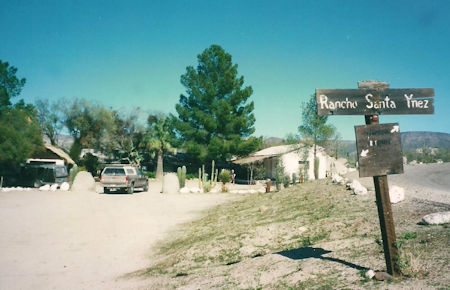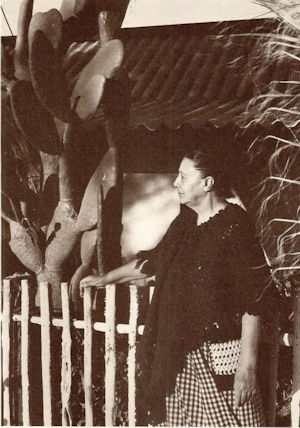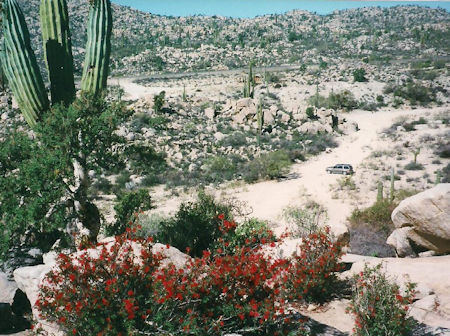 |  |
By Greg Niemann

Because of its strategic position far from anywhere, many Baja travelers along Highway 1 spend the night in the Cataviña area, an enchanting ethereal, boulder-tumbled landscape about 120 miles south of San Quintín (170 from Ensenada).
For years the Cataviña Pemex station was the only place to get gas in the entire area. When the pumps were empty long lines sometimes formed awaiting fuel. The Pemex is now closed, but you can still get gas from a couple private vendors and their 55-gallon barrels, but it can be pricy.
Outside of the mind-boggling jumble of boulders, boojums (cirios), and cacti, there’s not much there. The very small village of San Antonio de las Minas just off the highway hosts a couple of small restaurants/taco stands.
For lodging, there’s the government-built, comfortable Mision Cataviña Hotel, (formerly La Pinta), but for campers, RVers, or travelers on a budget, they might try the Rancho Santa Ynez (also spelled Ines). Less than a mile south of Cataviña, just after crossing a shallow creek bed dappled with native blue palms, turn left on the half mile road which leads to the iconic Baja rancho.
Rancho Santa Ynez has been welcoming travelers to this desolate location for years. Indeed, before the highway was paved nearby (1973) and accompanying accommodations built, everyone who drove the old road stopped at the remote and restful Rancho Santa Ynez. They even arrived by plane, stopping at the hard-packed airstrip built on the nearby knoll.

Operational today and regularly used for general aviation purposes, Rancho Santa Ynez (Inés) Airstrip (ICAO: MM23), also known as Cataviña Airstrip, is at Elevation 1843 in the middle of the Cataviña Desert National Reserve. The airfield is 3900’ by 100’.
Off-roaders, however, have been regularly stopping at Santa Ynez and the windows of the small kitchen/dining area are covered with their signature stickers. Santa Ynez has always been a good value, with typical ranch fare served: tacos, enchiladas, machaca, huevos rancheros, sodas and beer.
Wayfarers meet on hard dining room benches and compare notes under the illumination of a propane lantern which the managers turn off early. No problem – there’s a large level grassy field where guests can set up camp, complete with a plumbed restroom in its center. They also have a handful of small rooms at the rancho to rent at excellent rates. I’ve found their lodging to be as comfortable as the nearby hotel at a fraction the cost.
Rancho Santa Ynez RV Park
The large field is the Rancho Santa Ynez RV Park and offers 40 spaces. These days they charge just a few dollars per night, coming by in the morning to collect – if they remember. Even this year (2017) travelers have commented via social media that the large, grassy spot is THE spot to camp in Cataviña. One noted:
“Dry camping in a large hard packed dirt field with trees for shade, or a view of the Mexican Blue Palms in the arroyo (dry stream) far enough in from the Highway 1 as not to be bothered by noise. Beautiful spot to stay and explore the small cave paintings to the North as well as the amazing boulder fields.”
Señora Josefina Zuñiga Ramos

While the original owner of the land was a Senor Gonzalez, it was Señora Josefina Zuñiga Ramos who developed the rancho. She was born in 1904 to an upper-class family in Sonora, Mexico that had fled to Arizona and Calexico, California during the revolution. At age 17 Josefina moved to San Diego where she went to work in a department store. Speaking good English by this time, she also became the U.S. buyer for the Mexican Army stationed in the northern part of Baja California.
According to an article in the Mexico West Newsletter by Marvin Patchen (Sept. 1989), Josefina was shown home movies of Rancho Santa Ynez in 1956 and bought it sight unseen. She also acquired the adjoining land creating a rancho of 854 acres. (Ed note: Marvin and Aletha Patchen have been long-time Baja explorers who authored Baja Adventures by Land, Sea and Air (1981), and Baja Outpost (2003) which describes their hand-hewn cabin built on the other side of the Santa Ynez runway.)
The ruins of Santa Maria, the last Jesuit Mission (1767), are 14 miles in the mountains behind Rancho Santa Ynez. Perceptive Josefina also bought 47 acres surrounding the mission site to help protect and preserve the site. Today, a rugged, poorly maintained road goes to the site.
Josefina also helped develop Punta Final, a small mostly-gringo development on the Sea of Cortez. She was a true Baja pioneer and also established a clinic between the rancho and the highway—the only medical help for miles around. Patchen also reported that the clinic was built by the famous off-road racers Bill Stroppe and Parnelli Jones in her honor.
She was a friend to many of the off-roaders and the following excerpt from a 1972 Sports Illustrated article by Robert F. Jones covers the arrival of the infamous Parnelli Jones during the Baja 1000 there:
Parnelli blew into the fourth checkpoint, Rancho Santa Ynez, fully 10 minutes ahead of his schedule. Santa Ynez is one of the grace points of the Baja: a quiet green oasis amid the prickly boojum trees of the peninsula's midsection. Dogs doze in the sunny plaza and chickens squabble under their roost, the chassis of a devasted Baja Bug left behind during a long-forgotten race. There is beer in Santa Ynez, beaded bottles of Tecate that chill the palm and reward the howling throats of contestants and spectators alike. There is food at Santa Ynez, heaping plates of freshly cooked enchiladas, refried beans, tortillas that are as warm and soft as a Mexican lady's smile. And there is Señora Josefina Zuñiga. Clad in black, her hair bunned behind her, she walked in beauty like the night—replete with a serene gold-toothed smile—to the pit area when Parnelli screamed in. And she stood there awaiting the chance to do honors to the folk hero.
Josefina died in August, 1989 at the age of 86. Off-roader Brian Chuchua used his helicopter to erect a large cross on the mountain overlooking the rancho as a tribute to her. Her nephew and other family members still own Rancho Santa Ynez, but live in Ramona, California and have others as resident managers.
Señor Oscar Valdez Romero and his wife Matilda de Valdez have been running Santa Ynez for many years and were seemingly there every time I stopped. In 2002, he told me they’d been there over 20 years. They were still there in 2007. Sometimes they are assisted by their daughter Yesenia Valdez Rodriguez and her husband Jose Lucas Gomez Sanchez and family.
Marion Smothers in her book Vintage Baja mentioned Santa Ynez before the road was paved (And before turtles were designated endangered),
“After a sumptious dinner that could include quail, deer, carne asada or sea turtle—always with the Señora's famous enchiladas—we would share a campfire and music before turning in for the night. My fellow travelers were mostly truck drivers hauling live sea turtles north to Ensenada, trucks heavy with onyx from El Marmol, stake trucks loaded with cured hides, a Baja buff or two, sometimes a prospector with his burro train, once in a while a goat herder and his charges going God-knows-where, or a scientist, such as a botanist doing field collecting. A real mixed bag sharing the courtyard, sleeping under the stars.”
A Sparkling Ceiling Overhead

From the campground, the stars in the cloudless sky of this clear, dry desert dazzle even the most jaded camper, creating a sparkling ceiling so bright we didn’t need the flashlight. Then in the morning of that 1982 trip we enjoyed a hot breakfast before continuing our adventure.
While on a couple of other occasions I’d rented a room at Santa Ynez, in December 1996 I camped out again, sleeping in a pickup camper on a rainy night, hearing the drops pound the metal above our heads. It was muddy in the morning, but not the quagmire I’d feared.
Over dinner we met a couple of German bicyclists who had come to “Challenge the Baja.” The camaraderie of diverse strangers sharing experiences and warmth is part of what lures many to explore Baja.
While the tourist hotels have allowed more people to drive the length of the Baja California peninsula, ranchos like Santa Ynez and their star-studded sleeping quarters are Baja legends that will endure.
About Greg
Greg Niemann, a long-time Baja writer, is the author of Baja Fever, Baja Legends, Palm Springs Legends, Las Vegas Legends, and Big Brown: The Untold Story of UPS. Visit www.gregniemann.com.

Day, night, while they are on vacation. Anytime. They are the best most helpful insurance companies...

I have been a customer for years and when I really needed them they stepped up in every way. I had...

Reasonable prices and we thought best chance to actually get results if we needed them.